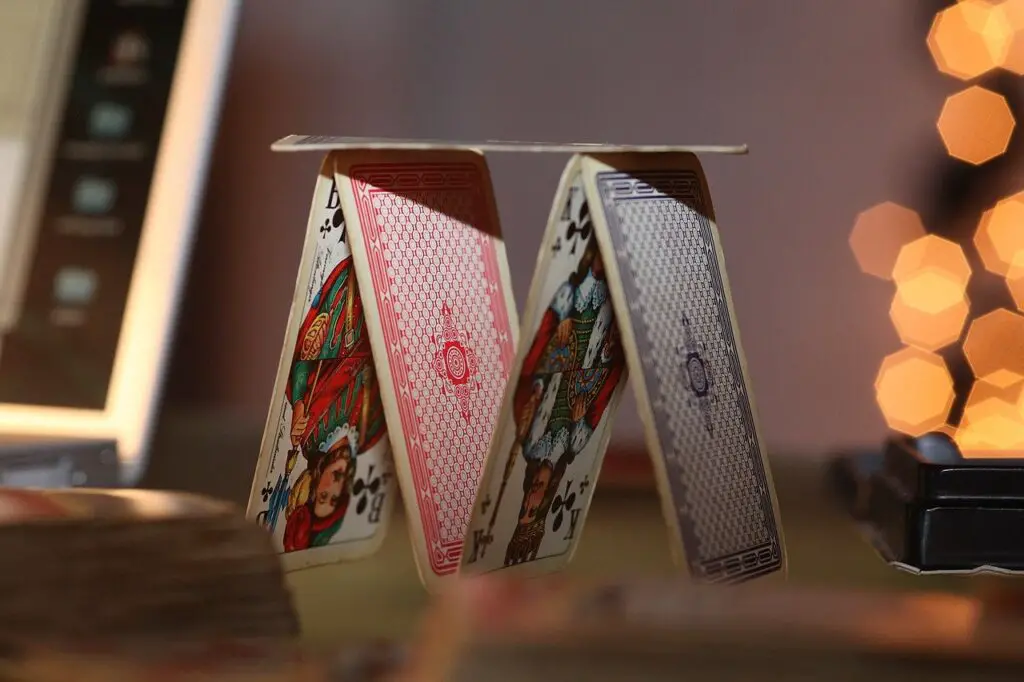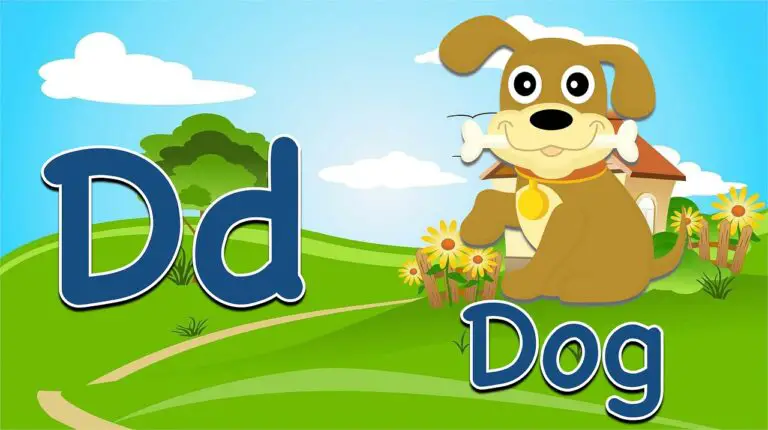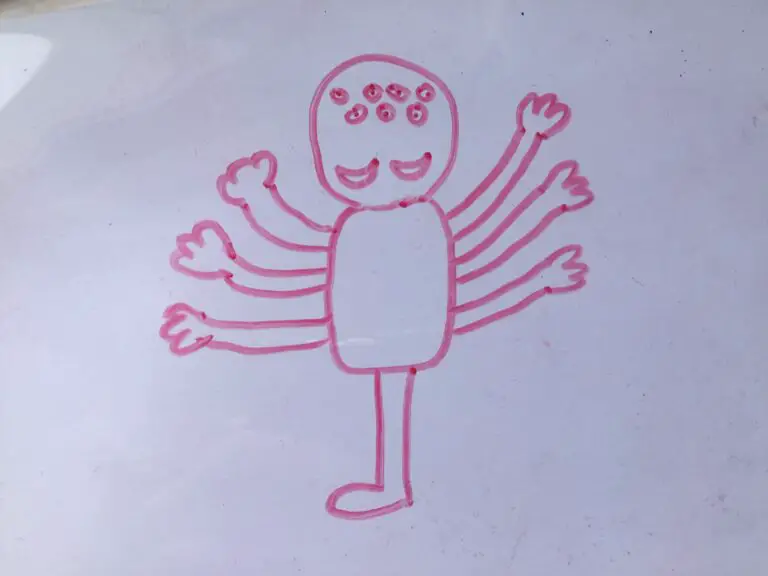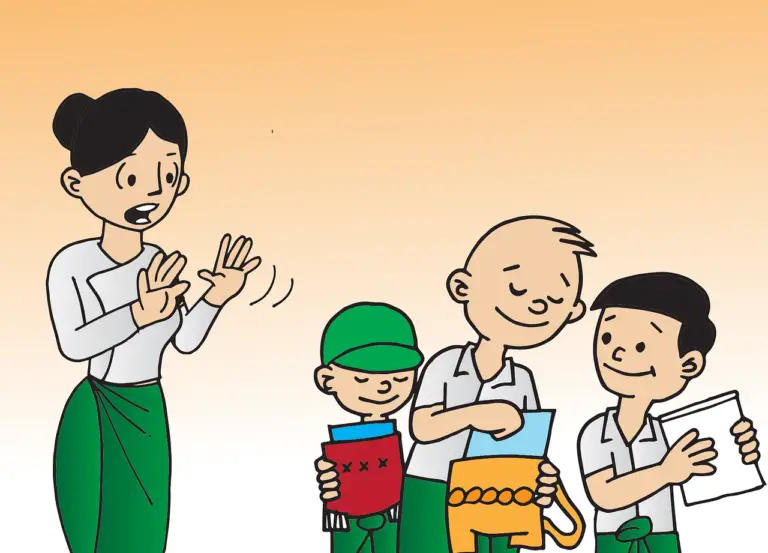A deck of playing cards offers endless possibilities. Think of all the games that use the standard 52-card deck – there are thousands. And more than just games, you can do other fun activities, too.
18 months ago, I bought a pack of cards to use in my EFL/ESL classes. It cost me 1 euro. Since then, I’ve used it on a weekly basis with students of all ages and abilities, and while the box is falling apart, all 52 cards still provide the basis for great of learning.
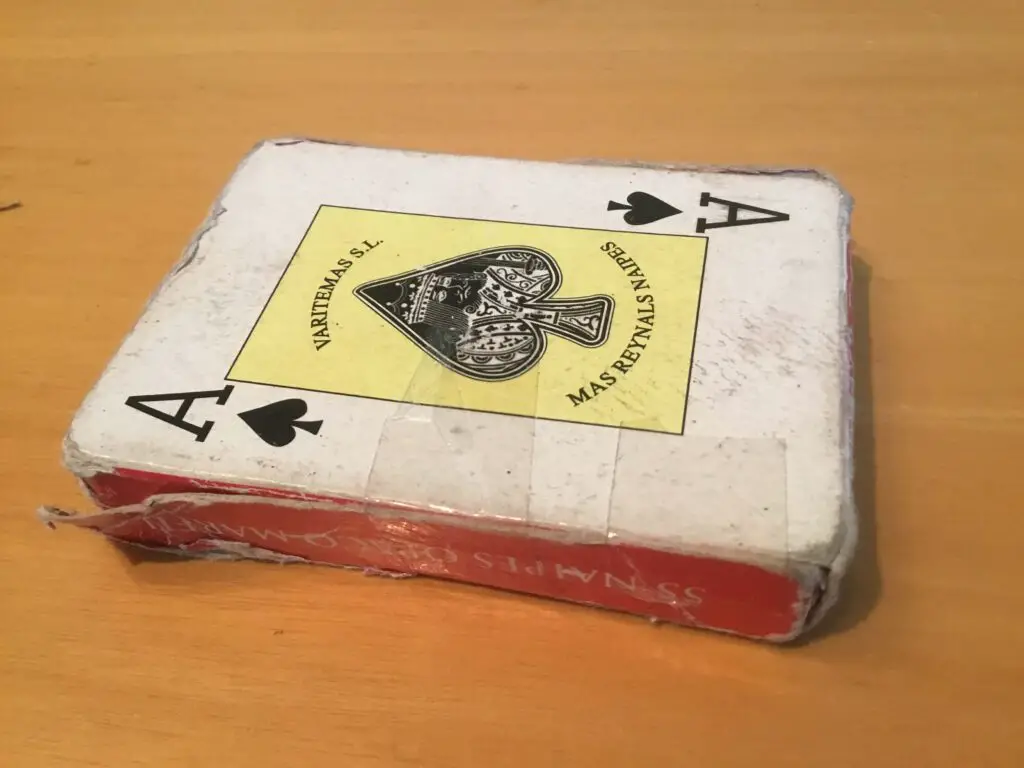
I’d like to share with you 9 of the best activities I’ve done with my students using this ultra-cheap resource.
- Magic tricks
- Cheat (I Doubt It)
- Random story builder
- Go Fish
- What Card Am I?
- House of cards
- Pairs
- Fortune telling
- Negotiation
How to teach with cards
Before we get into the list, it’s worth talking about different types of playing cards and how to help your students get familiar with them.
The 4 suits of hearts, diamonds, clubs and spades with numbers 2-10, J, Q, K, and Ace are what you’re probably familiar with. They’re the most common and established cards globally.
But, as I found when I moved to Spain, they aren’t the only ones. Here, they use different suits (cups, coins, swords and batons) with numbers 1-12. The Italian deck is similar. And in Germany and Switzerland they have acorns, leaves/roses, hearts and bells.

Check out this article on Atlas Obscura to learn more about the history of playing cards.
The point is, don’t assume your students are familiar with normal cards. You’ll have to teach them the names of the Jack and Ace as a minimum, and the names of suits will be required for some of these activities.
I like to write the suits and values on the whiteboard or on A4 dry-erase pockets so they have a reference throughout the class.
NOTE: None of these activities require any jokers. I remove them from the box so they don’t get mixed in with the other cards. However, you may wish to include the joker(s) in some activities.
With that out of the way, let’s get to the list!
1. Magic tricks
Everyone loves a magic trick, but most of them are overly complicated or require a lot of skill. However, there are a few which are great for EFL/ESL.
Estimated time: 10 minutes
Energy level: 2/5
Group size: Any
I particularly love this one:
It’s super easy to learn and works every time. Not only that, it practices the alphabet and spelling too – in trying to get the trick right, they’re motivated to be accurate.
Kids especially love showing tricks to their friends and family.
By learning magic tricks, students listen to instructions as well as getting great speaking practice when they perform them.
2. Cheat (I Doubt It)
Cheat, also known as “I Doubt It”, has many variations. I like it because it practices numbers with beginner students and provokes discussion and suspicion with more advanced learners.
Estimated time: 10-15 minutes
Energy level: 2/5
Group size: 4-12
How to play
Deal out all 52 cards equally.
The first player places one or more cards face down in the middle of the table, saying “One Ace”, “Two Aces” or “Three Aces” depending on how many they put down. Alternatively, they can say “pass” and don’t put down any cards. Really, they can put down whichever cards they like.
If anyone thinks they haven’t put down what they said they did, they can call out “cheat!”
When this happens, reveal the cards. If the player was telling the truth, the challenger takes the cards and adds them to their hand. If the player was lying, they take the cards themselves.
If nobody calls cheat, play moves around in a clockwise direction. The next player can put down Aces (or cards they claim are Aces), or pass. Again, anybody can call cheat, like before.
This keeps going until someone calls cheat, or everyone has passed. When either of these things happens, you move on to “Twos” (and then threes, then fours, etc.). If everyone passes, remove the cards in the middle of the table from play.
When somebody gets rid of all their cards, they win.
Note on passing: If you pass, you are out of the round until someone calls cheat or everyone passes. So if you pass on Aces, you can’t put anything down until play moves on to Twos.
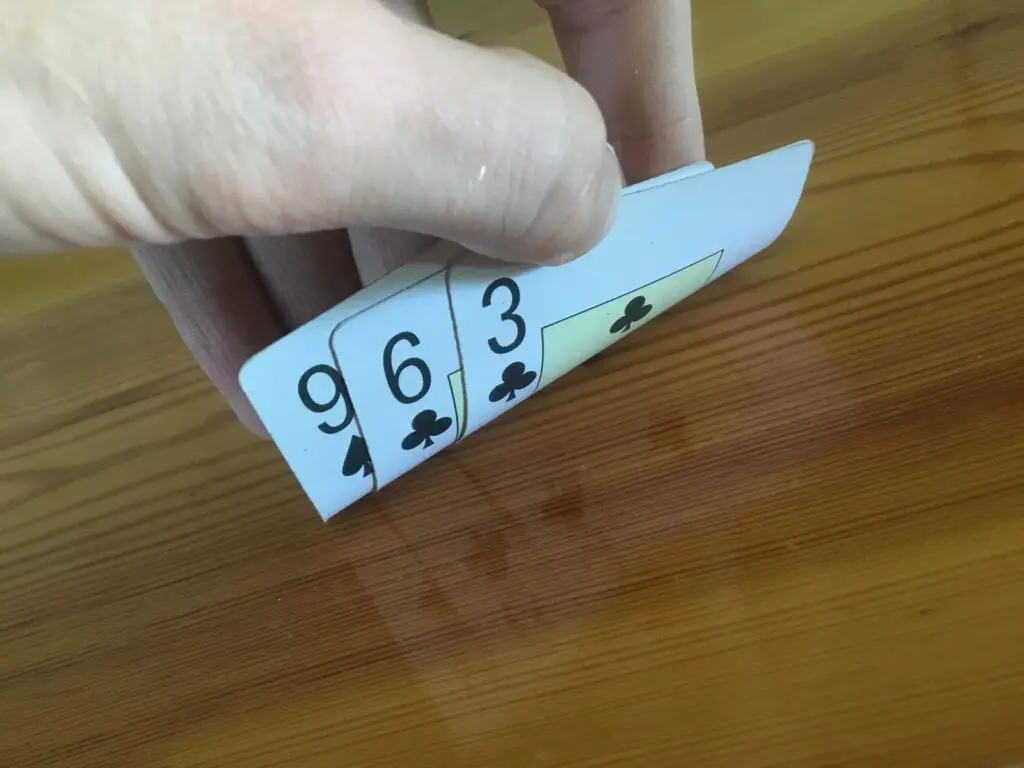
There’ are quite a lot of variations, and what I’ve listed isn’t the standard game of Cheat. I’ve found the standard rules can be fun, but it often ends up with one student holding nearly all the cards. It gets messy quickly.
For the full rules and variations, head to the Wikipedia article, Cheat (game).
TIPS
- With large groups, consider using two decks.
- Encourage students to use language (questions, interjections, etc.) to work out if someone is lying or not.
- Change the word “cheat” to “I doubt it” or “I’m not sure about that” to introduce some new phrases.
3. Random story builder
This one requires a little set up, but creates some funny stories and practices specific target vocab. It’s also flexible – you can use it for writing or speaking.
Estimated time: 10-30 minutes
Energy level: 3/5
Group size: Any
Before the class, prepare a list of words corresponding to each of the 52 cards. There are a few ways of doing this depending on the level of your students and what you want to achieve:
- All 52 cards are different nouns (best for beginners)
- Red cards are nouns, and black cards are verbs
- Assign each suit a word type: nouns, verbs, adjective and adverbs (only for intermediate/advanced classes)
Divide your class into pairs or small groups. They each draw 5 random cards (fewer for beginners or more for advanced students) and find out the corresponding words. With these words, they have to write/tell a story.

It’s as simple as that. But you can go even further:
- Keep the cards a secret from other groups and when they write/tell the story, the others have to guess which cards were drawn
- Turn it into a dramatization or role-play
- For very confident students, create an improv session where you draw the cards one at a time and they have to invent the story on the fly.
4. Go Fish
This is an EFL/ESL favourite. It practices asking questions with “have you got any _____” or “can you give me any _____?”
Estimated time: 10-15 minutes
Energy level: 2/5
Group size: 4-8
How to play
Deal out 5 cards to each player. Place the rest of the deck face down in the middle.
The aim of the game is to get sets of 4 cards of the same number/value. Each set is worth 1 point.
Starting left of the dealer, players take turns asking other players if they have any cards of a certain value. For example, Samuel asks, “Ana, do you have any eights?”
If Ana has any eights, she must give ALL of them to Samuel. Then Samuel can ask another question to Ana, or any of the other players.
If Ana doesn’t have any eights, she says “No, go fish.” Samuel takes a card from the deck in the middle and his turn ends. Play then passes to the next player in a clockwise direction.
Important rule: Players can only ask questions about cards of which they already have at least one. So, if Samuel doesn’t have any threes, he can’t ask anyone for threes.
When a player gets a set of 4, they place them face up on the table, and earn one point.
The game ends when all the cards are in sets of 4 on the table. Most points wins.
Check out the video below for a visual explanation.
Students love figuring out which cards the other players have and stealing them at the last moment.
TIPS
Vary the questions so it doesn’t get repetitive.
- Do you have any _____?
- Have you got any _____?
- Can you give me any _____?
- Please, hand me all your _____.
Likewise, encourage students to say yes or no in different ways.
- Of course
- Here you go
- Absolutely
- I’m afraid I don’t have any
- Nope, not this time
- Sorry, I can’t do that.
5. What Card Am I?
A simple game which practices asking questions and comparatives. You’ll need a timer for this one.
Estimated time: 1 minute per round
Energy level: 4/5
Group size: Any
How to play
One student takes a random card and, without looking at it, places it on their forehead so everyone can see it.
Set the timer for one minute. During that time, the student has to ask questions to the rest of the class to figure out what card it is.
Questions must be “yes” or “no” – the rest of the class isn’t allowed to give any more information.
At the end of the minute, the student must guess what card they have.
As you can imagine, there will be plenty of questions using “higher than” or “lower than”, so make sure to go over comparatives if your students might struggle with that kind of language.
TIPS
- If students just take random guesses and don’t get anywhere, step in to model some useful questions beforehand, like “Is it a red card?” or “Is it higher than 7?”
- Challenge advanced students with a shorter time, or extend it to 90 seconds for those who can’t get it done within a minute.
- Make it a competition between teams.
6. House of cards
Not the most complicated on this list.
It’s more of a project and team-building exercise with English used to communicate and organise.
Have your students collaborate to build a house of cards together. With a larger class, split them into small teams and see who can make the best structure within a set amount of time.
Or even have them build a bridge between two tables for added difficultly.
7. Pairs
A classic game of matching. You can adapt it to practice specific vocab, or make it into a group activity where students communicate to make the right choices.
Estimated time: 10 minutes
Energy level: 2/5
Group size: 1-6
I imagine you already know the rules, but here they are just in case you’ve somehow missed out on one of the most famous games of all time.
How to play
Shuffle the cards and lay them out face down on the table, so no cards are touching.
The aim is to find all the matching pairs (cards of the same value and colour – so the 3 of hearts goes with the 3 of diamonds).
The player turns over two cards and sees if they match. If they do, they take the cards off the table. If they don’t match, they turn the cards face down again, then try two new cards.
The game ends when all the matching cards have been found.

TIPS
There are two ways to make this a little more exciting and relevant to English.
The first is to use custom made cards with:
- Vocabulary (one is the word, the other is the picture)
- Synonym pairs
- Antonyms or opposites
- Singular nouns and their irregular plurals (e.g. foot and feet)
- Verbs and their irregular past forms (e.g. go and went)
The second method is to encourage collaboration (or competition)
- Students work as a team and have to communicate what cards they remember seeing
- Time them to add some urgency (make sure they aren’t cheating, only two cards visible at any one time), and challenge them to get better each time they play.
- Have multiple teams competing to finish first. Again, you’ll have to police them heavily as they’ll cheat a lot.
8. Fortune telling
Estimated time: 5 minutes per reading
Energy level: 2/5
Group size: Any
For the past, present and future, look no further than this activity. It’s similar to using tarot cards to give readings, but you don’t need to buy the special tarot decks.
Instead, check out this website: https://cafeastrology.com/fortunetellingcards.html. It shows you what each card in a standard 52-card deck means.
Note: I don’t believe in tarot cards or any other astrological fortune-telling methods. But they’re fun. I recommend expressing this to your students. The activity is to practice English and have a bit of a laugh – they shouldn’t take any of the results seriously.
When your students do a reading, they draw a card, or multiple cards, for the past, present and future.
With beginners, just one card for each tense is enough. For advanced students, have them draw 3 for each, giving 9 in total.

Then you figure out what each card means, and try to apply it to their lives. The power of tarot cards is that each is vague enough to make associations with everyone if you’re creative enough.
Get your students to link their lives to the cards and come up with a prediction of the future. I repeat – it’s just a bit of fun.
If you’re worried about things getting heavy and personal, do a reading of an imaginary character and invent things about them. Alternatively, combine this activity with the random story generator earlier. If you’re still unsure, just avoid the activity entirely.
9. Negotiation
Ideal for business English classes, but most groups can have a great time. It’s a little more complicated than the other games on this list, but it’s worth the effort of learning it. Avoid playing this with beginners or children under the age of 12.
Estimated time: 15 minutes per round
Energy level: 4/5
Group size: 4-12
This game practices language for negotiating, compromising and striking deals with a competitive element, as well as working against the clock. You’ll need a timer.
How to play
Before the game, remove a number of random cards from the deck according to the number of players (see table below). Don’t show these cards. With 8 or more players, use two decks.
Deal the rest of the cards so everyone has an equal amount. Let everyone take a minute or two to look at their cards.
Set a timer for 10 minutes. When the time begins, players must negotiate with each other, trading cards in order to create groups of the same suit or runs of consecutive numbers.
Players may show each other their cards or keep them secret. Trades don’t have to be one-for-one. Trades are not final – they can be reversed if both parties agree.
When the time runs out, all trading must stop.
Award points for collections of associated cards, as shown in the points lists below (basic and advanced). Cards can contribute to multiple collections – the 6 of hearts could be in a collection of cards of the same suit (hearts) AND a run of consecutive numbers, e.g. from 3 to 9.
The player with the most points at the end wins.

| # Players | Total Cards | # Cards to Remove | # Cards per Player |
|---|---|---|---|
| 4 | 40 | 12 | 10 |
| 5 | 50 | 2 | 10 |
| 6 | 48 | 4 | 8 |
| 7 | 49 | 3 | 7 |
| 8 | 80 (2 decks) | 24 | 10 |
| 9 | 90 (2 decks) | 14 | 10 |
| 10 | 100 ( 2 decks) | 4 | 10 |
| 11 | 99 (2 decks) | 5 | 9 |
| 12 | 96 (2 decks) | 8 | 8 |
Basic points scoring
For cards of the same suit:
- 3 cards of the same suit = 1 point
- 4 cards of the same suit = 2 points
- 5 cards of the same suit = 3 points
- 6+ cards of the same suit = 1 point for each
For consecutive runs of numbers of any suit (King -> Ace -> Two is NOT a valid run):
- 3 consecutive cards = 1 point
- 4 consecutive cards = 2 points
- 5 consecutive cards = 3 points
- 6+ consecutive cards = 1 point for each
A card cannot be used in more than one run.
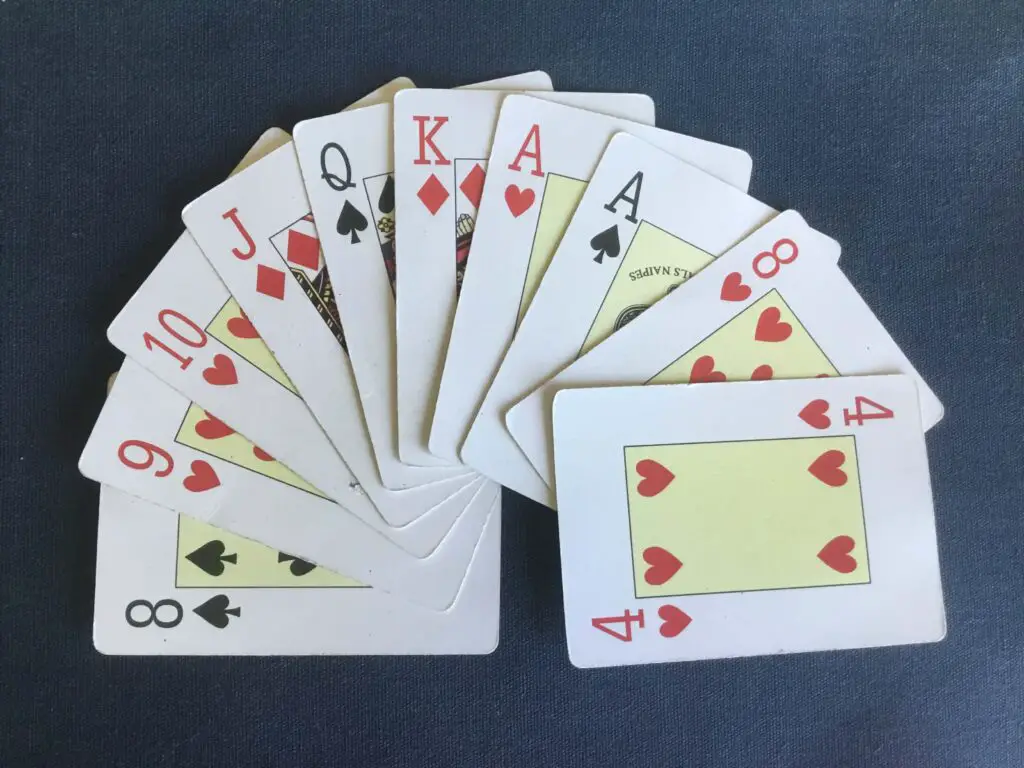
The hand in the picture above, the player would score: 7 points for a run (8, 9, 10, J, Q, K, A), 2 points for having four hearts, and another 2 points for having 4 spades. This gives a total of 11 points.
Advanced points scoring
To make the game richer and more complex, you can introduce additional ways to get points:
For cards of the same value:
- 3 cards of the same value = 1 point
- 4 cards of the same value = 3 points
- 5+ cards of the same value (2 deck games only) = 1 point for each
For consecutive runs of cards in the same suit:
- 3 consecutive cards of the same suit = 2 points
- 4 consecutive cards of the same suit = 4 points
- 5 consecutive cards of the same suit = 6 points
- 6+ consecutive cards of the same suit = 2 points for each
TIPS
- For a collaborative variation, get the players working together to get the most possible points as a group. To make this harder, only give them 5 minutes.
- Play the first time with the simple points scoring, then judge if your class is ready to step up to the advanced version.
- Take part yourself and model appropriate language for negotiation.
- Getting used to the points system can take a couple of rounds, so have patience with your students and go through the scoring systematically.
Play the hand you’re dealt
There are activities on this list for everyone – beginners right up to advanced learners and business students.

Not all of them will suit every class. But if you think you could adapt one of them to suit the needs of your group, go ahead – that’s what makes a great teacher.
With a little creativity and innovation, a simple deck of cards for can go a long way. There are so many possibilities – we didn’t even mention popular games like poker, bridge, and whist!
Go experiment. Find out what your students love, and bring enjoyment and learning to every lesson.
If you’re looking for more games and activities, check out my other lists:
9 EFL/ESL Speaking Games & Activities Perfect for Beginners
9 EFL/ESL Games & Activities for Intermediate Learners
9 EFL/ESL Games and Activities for Advanced Learners
9 High Energy EFL/ESL Games for Boosting Vocabulary
9 Engaging Homework Ideas for EFL/ESL: No worksheets!
9 Exciting EFL/ESL Activities for Writing & Spelling
9 Fun EFL/ESL Games & Ideas With Standard Playing Cards
9 EFL/ESL Games With No Materials or Preparation Needed
9 EFL/ESL 5 Minute Games Every Teacher Needs to Know
9 Superb EFL/ESL Games & Activities Using Just Pen & Paper
9 Classy EFL/ESL Games & Activities for Adults (+ tips)
9 Confidence-Boosting EFL/ESL Speaking Games for All Levels
9 Exciting Flashcard Games for EFL/ESL Classes


